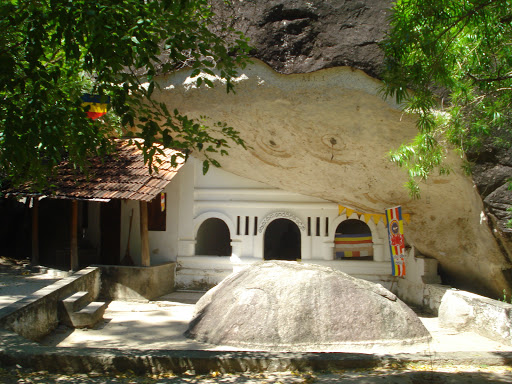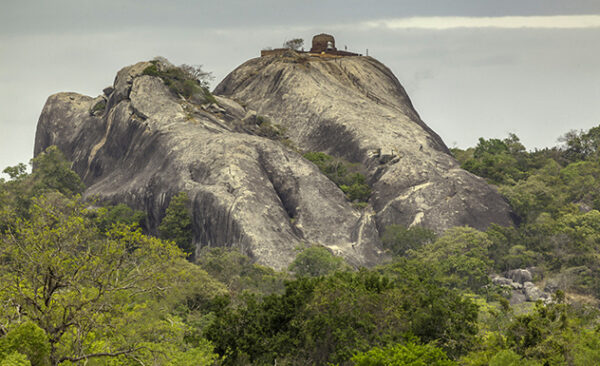Kudumbigala Forest Hermitage – Sri Lanka’s first Buddhist Monastery
By Arundathie Abeysinghe
 Dating back to 246 BC, the era of King Devanampiyatissa (247 BC – 207 BC), Kudumbigala Forest Hermitage is the first Buddhist Monastery built for Buddhist Monks in Sri Lanka and has immense historical value. The Monastery is also known as “Chetiya Pabbatha” and is home to the only cylindrical dagoba (stupa) in Sri Lanka. According to scholars, this is the only dagoba in Sri Lanka that had been built according to Dhammachakka Stupa in Saranath in India. This brick dagoba is the only remaining structure, whereas the other dagobas which had existed in the past have been destroyed over the years.
Dating back to 246 BC, the era of King Devanampiyatissa (247 BC – 207 BC), Kudumbigala Forest Hermitage is the first Buddhist Monastery built for Buddhist Monks in Sri Lanka and has immense historical value. The Monastery is also known as “Chetiya Pabbatha” and is home to the only cylindrical dagoba (stupa) in Sri Lanka. According to scholars, this is the only dagoba in Sri Lanka that had been built according to Dhammachakka Stupa in Saranath in India. This brick dagoba is the only remaining structure, whereas the other dagobas which had existed in the past have been destroyed over the years.
Situated in Panama about an hour’s drive from *Arugam Bay in the southernmost corner of the Eastern Province, sprawled across 6000 acres of a rocky outcrop and in a picturesque setting in Kudumbigala Forest, this ancient Monastery Complex had been built as cave dwellings for meditating monks who preferred to get away from chaos in life and follow the path to *Enlightenment.

According to archaeologists, there are over 200 caves within the Monastery Complex, with rock ridges and big granite boulders, each cave with huge stone slabs to ensure the ascetic monks were not disturbed (during meditation); live in an environment of serenity and tranquility, essential features of Buddhist Meditation. There is a Buddha Statue in one of the caves. The location of the Monastery Complex in * Kudumbigala Sanctuary is a haven for ascetic monks.

*Brahmi inscriptions under the drip-ledges of the Caves in the Monastery Complex that can be seen at present too, reveal significant information of yesteryear. According to one stone inscription found in one of the caves named “Maha Sudarshana Lena”, the Monastery Complex had been used by Buddhist Monks. According to legends, this cave had been gifted to Buddhist Monks by Nandimitra, a warrior giant of King Dutugemunu (161 BC – 137 BC).
Kudumbigala Forest Hermitage is known as “forgotten Buddhist Kingdom” by many as the site was abandoned for a long time and was not a well-known hermitage until it was rediscovered in early 1950s by *Upasaka Maithree.
The path leading to the Monastery Complex is steep and it is a challenging hike. The vistas from the summit of the Peak are breathtaking, sunrise as well as sunset views, when the views are surreal. Hence, the majority of tourists are of view that the hike is worth the effort. The impressive bare rocky outcrop with remains of a dagoba and many caves at the base of the rocky outcrop with rock inscriptions is of immense historical as well as archaeological value. At present, the ruined temple complex at the base of the rocky outcrop is occupied by monastic Bhikkus.

Image courtesy: destimap.com & bestofcylon.com
- Arugam Bay – A famous surfing destination on the east coast of Sri Lanka and popularly known as “Arugam Kuda” by locals.
- Brahmi inscriptions – The earliest writing system developed in India after the Indus script and considered as an influential writing system. All modern Indian scripts as well as several hundred scripts that are in South Asia, Southeast and East Asia are derived from Brahmi.
- Enlightenment – In Buddhism, Enlightenment is when a Buddhist finds the truth about life and stops being reborn as he/she has reached *Nirvana.
- Kudumbigala Sanctuary – The Sanctuary is 4403 hectares in extent and was declared a sanctuary on September 28, 1973. Enriched with natural beauty, Kudumbigala Sanctuary is engulfed in verdant vegetation and home to a variety of birds and animals, some endemic.
- Nirvana – It refers to a release from the cycle of death and rebirth, the ultimate spiritual goal of Buddhism.
- Upasaka Maithree – A Catholic from Negombo who worked in Sri Lanka Railways had discovered Sri Lanka’s ancient history and in 1954, he had come to Kudumbigala Monastery Complex. He had cleared the area surrounding the Monastery Complex and cleaned the Complex and had settled down in the monastic abode to lead a life of seclusion. He had safeguarded the place during his lifetime. Upasaka Maithree is regarded as the “hero who protected the historic place” alone until he passed away in September 10, 1971. According to locals, when he passed away, his remains had been securely stored in a glass box and kept for display inside a rock cave within the Monastery Complex according to his wishes until 1994.







